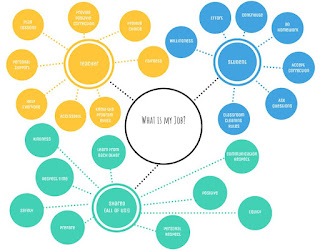Informed Eclectic...Again! – Unit 5 Reflections
In week
three I was introduced to the idea of being an “informed eclectic”.
I felt comfortable with that term and want to revisit it now in
week five.
This
week, we have been focusing on teaching methods. We have examined
what they are, what they mean, how they are used, and the
chronological history of when they came to be, within what I will
term recent history.
It was
relatively easy for me to understand most of the methods I read about
and see how they might be used in the context of a current classroom.
While I recognize that the methods are there, have names and
identifying features, I think my goal would be to be “...both an
informed and eclectic teacher...” (Brown & Lee, p. 18) so I
“...think in terms of a number of possible pedagogical options at
[my] disposal for tailoring classes to particular contexts.” (Brown
& Lee, p. 18) That seems right and good to me.
As I
explore this idea more, I think that I do not really have a choice in
the matter – I have to be an informed eclectic. What does
effectiveness as a teacher look like? Since fair is not equal (it is
not with my children and it is not in the classroom), it means that
whether or not I am comfortable or able to identify my method or
methods, I need to recognize that I am using methods that will impact
people. So, since it cannot be the same for everyone, and since
situations change, somehow I have to be able to adapt so that I can teach fairly and effectively. Understanding
and applying the various methods will help me do that.
As I was
reading, I realized that I used these methods on myself when I went
to college years (and years) ago! I listened to classical music to
stimulate my mind when reading textbooks. Music without words helped
keep me alert, but does not distract because there are no words that
require focus. I still love Vivaldi's Four Seasons
years later. This is reminiscent of “Suggestopedia” - a method
where music helps to create a relaxed state of concentration for the
learner. I recited relevant terms, committing them to memory as you
would using the Classical Method or Grammar Translation Method. We
had study groups – reminiscent of Community Language Learning; and
used the Silent Way and Discovery Learning to uncover new ideas and
truths for which we were engaged in contemplation and problem
solving. And while I did not use Total Physical Response (that I can
remember), I do remember seeing a project delivered through a
choreographed dance number. There is an appropriate application of
all methods, and the difficulty will be determining when and where to
use the methods to achieve the outcomes you desire.
Then
I wondered, that might be how I taught myself or impacted my own learning, but which
methods have I used to teach others? Through parenting and coaching
softball, I have regularly used the concepts of Total Physical
Response. Sometimes you have to demonstrate physically what you
want, and you verify learning by having it demonstrated back to you.
Sometimes you let your children or ball players “figure it out” -
that might be the Silent Way or Discovery Learning. We definitely
used the Natural Approach – we are constantly looking for
opportunities to use daily life or relevant moments in ball games to
become teachable moments. I have employed the Classical Method, the
Series Method, the Audiolingual Method.
So,
where does this leave me? Well, at least in part, I am encouraged to
use my intuition to plan and guide my teaching because I am doing
these things anyway. Somehow, I am at least partly on the right path
and that is comforting to know. The difference is now I understand
the theory behind the practice, and that should help guide
effectiveness. Knowing “what” is helpful. Knowing “how”
takes practice. Knowing “why” is key. In learning more about
the “why” this week, I think I have a good shot at being better
at the “how” and the “what” in a classroom, in life. That is
a good place to be in week five.

Comments
Post a Comment